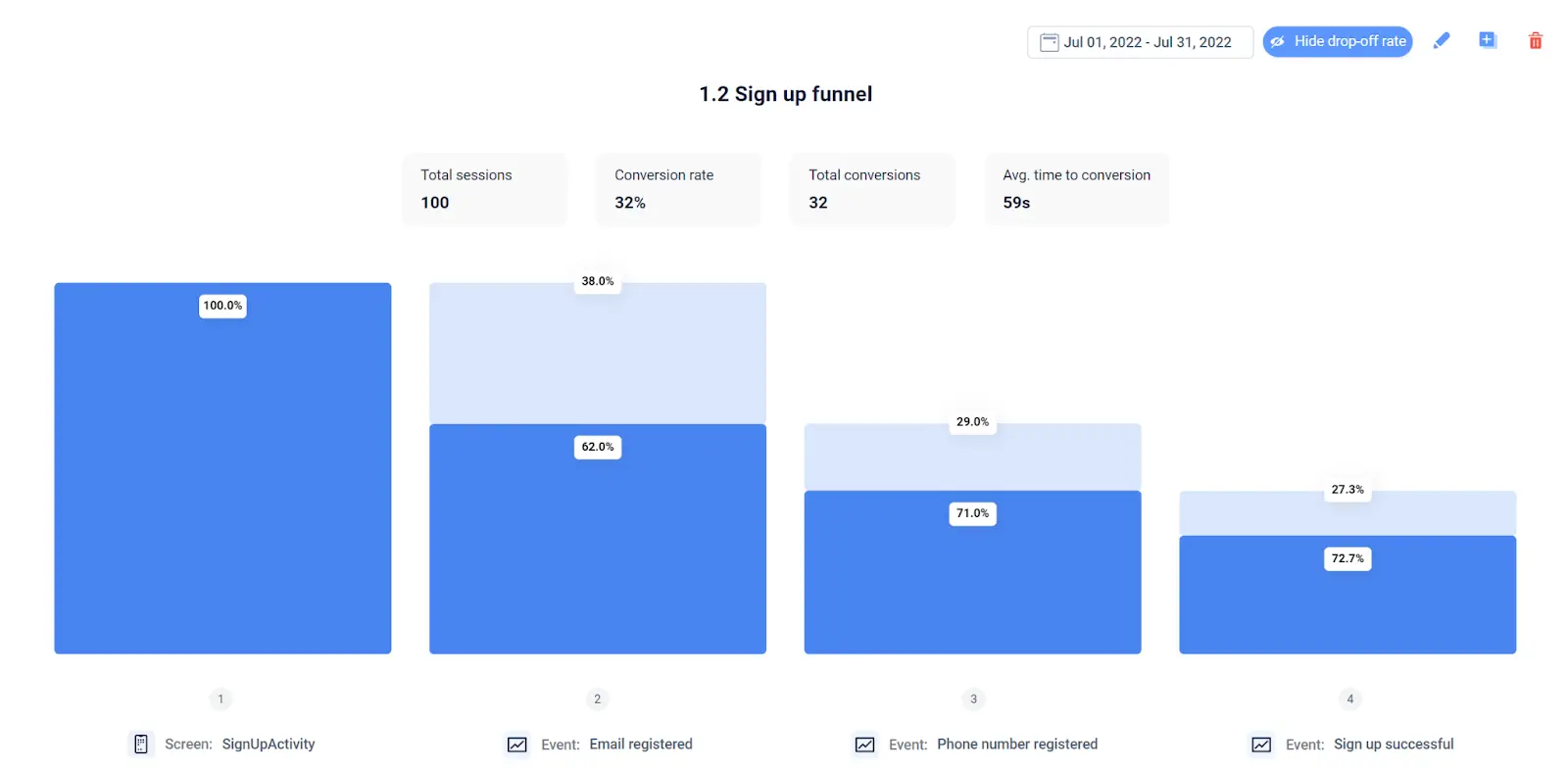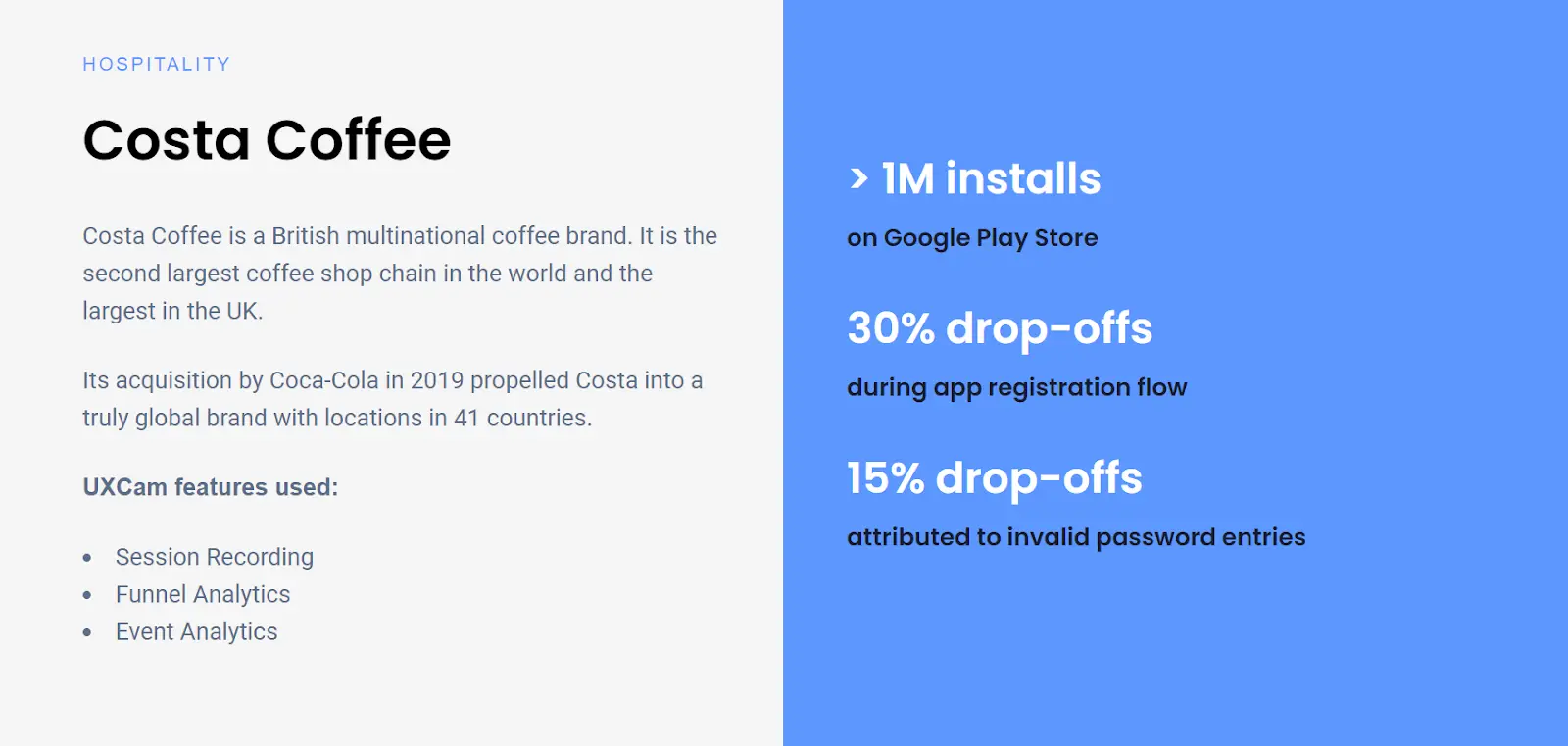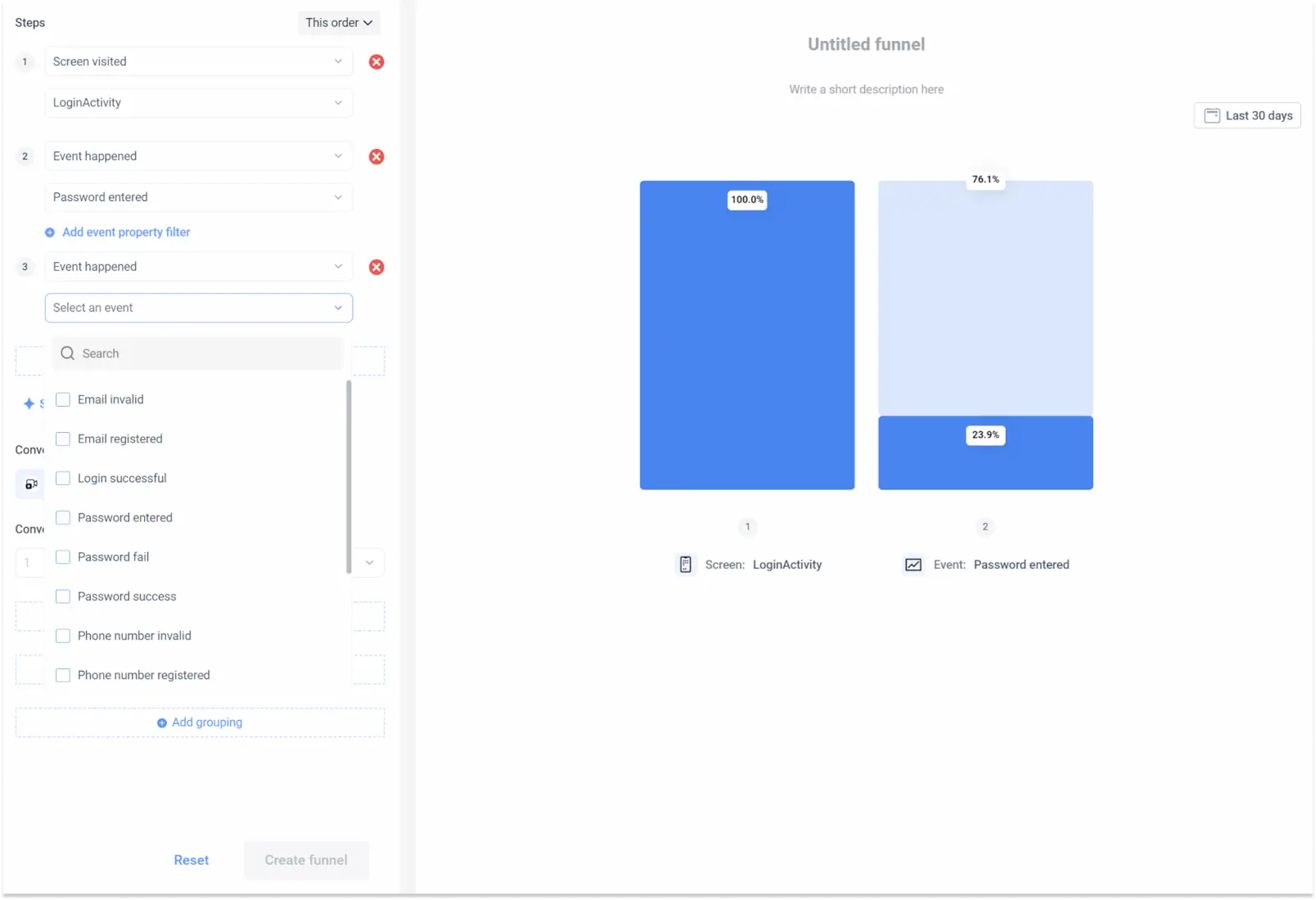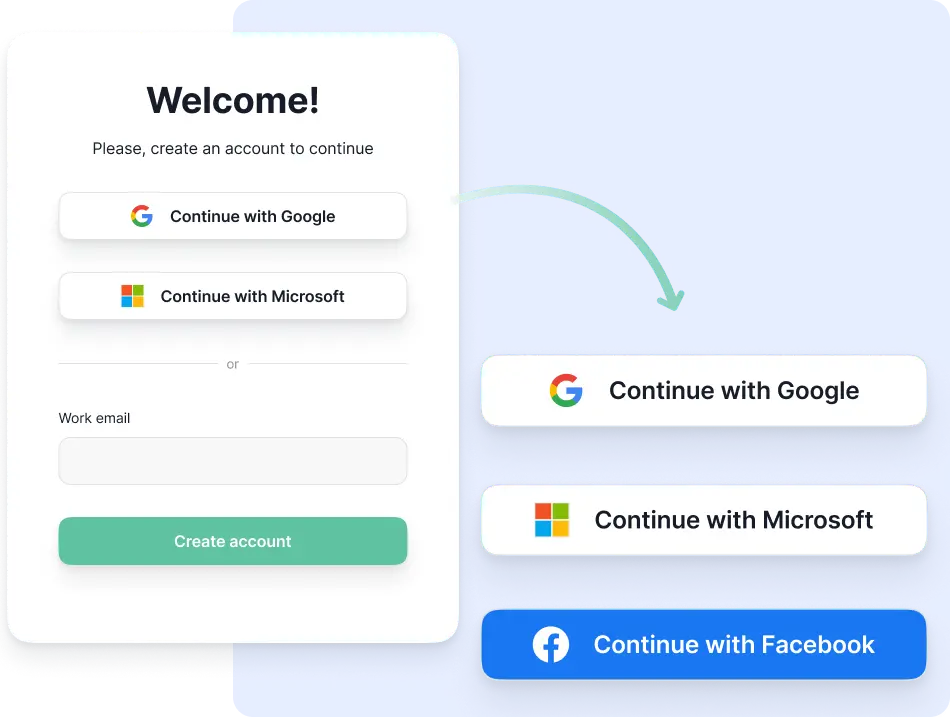Back to blog
5 MIN READ
Funnel Drop-Off Rate - Benchmarks & Strategies to Improve
PUBLISHED
13 November, 2024

Product Analytics Expert
Everyone wants to optimize their funnel conversion rates.
But if the goal is more conversions (and it usually is), the conversion rate metric on its own isn’t incredibly helpful. You need to track drop-off rates for insights into where your funnel is letting you down and costing you conversions.
In this guide, we’ll introduce you to this powerful metric, explain how to calculate drop-off rates, and provide tips and strategies for improving them.
What is funnel drop off rate?
A funnel drop-off rate is the percentage of users who don’t move onto the next stage of a funnel.
In the example below, we’re looking at a sign-up funnel.

The top of the funnel is the app’s sign-up screen, and the bottom of the funnel is successfully creating an account. In an ideal world, every user that enters this funnel would reach the bottom—but that’s not what happens here (or anywhere else, for that matter).
Between each pair of stages, people drop out of the funnel:
Stage 1 ⇾ Stage 2: 38% drop-off rate versus the overall total.
Stage 2 ⇾ Stage 3: 29% drop-off rate versus the previous total.
Stage 3 ⇾ Stage 4: 27.3% drop-off rate versus the previous total.
What do these drop off rates tell us? A lot.
We can immediately see an exceptionally high drop-off rate between stages one and two. This suggests users may have difficulty registering their emails—something we can quickly investigate using tools like session replay or heatmaps. To effectively reduce these drop-offs, it's crucial to understand why users abandon your app. Use UXCam to discover the complete user journey and see what makes users stick with your app.
What is a “good” drop-off rate?
Speaking of “high” drop-off rates, what makes a drop-off rate good or bad?
Unfortunately, there’s no single answer to this question—it depends on the funnel, its stages, and your goals. An example of the variation is that an e-commerce app’s checkout funnel will generally see lower drop-off rates between stages than its account creation funnel since many e-commerce shoppers see account creation as a burden.
The only ways to determine whether a drop-off rate is “good” are to:
Benchmark it against data from your industry
Benchmark it against similar funnels from your business
Investigate drop-offs that seem high through analytics and product experimentation
How to calculate funnel drop-off rate
There are two main ways drop-off rates are calculated:
Last-first-first step
This method gives you the percentage of users who entered the funnel that exited a specific stage.
How to calculate drop off rate
The formula is:
(number of users who exited current stage – number of users who entered funnel) / number of users who entered funnel x 100%
To illustrate, imagine 100 users entering our funnel, but 20 users exit at stage three. We take the number of users who exited stage three (20), subtract the total number of users who entered the funnel (100), divide the result by the total number of users who entered the funnel (100), and multiply the result by 100% (-80%).
While this method can be useful, it isn’t very helpful for directly comparing the stages in a funnel.
Current-previous-previous
This method allows for direct comparisons between two stages. It gives you the percentage of users who exited the previous and current stages.
Drop off rate formular
The formula is:
(number of users who exited the current stage – number of users who exited the previous stage) / number of users who exited the previous stage x 100%
To illustrate, imagine that 20 users exited stage two of our funnel and 15 exited stage three.
To calculate a drop-off rate for stage three, we would take the number of users who exited stage three (15) and subtract the number of users who exited stage two (20). We then divide this result by the total number of users who exited stage two (20) and multiply the result by 100% (-25%).
Practical strategies to reduce funnel drop-off rate
1. Find your biggest bottlenecks
Bottlenecks are points in your funnels that cause a large number of drop-offs. Finding your biggest bottlenecks using an analytics tool and building fixes is the easiest way to boost funnel performance.
Costa Coffee used UXCam to do precisely that.

The company wanted to understand why 30% of users dropped off during their registration funnel. They set up custom events for key registration moments, built funnels to understand where users were struggling, and found that 50% of drop-offs happened when an invalid password was entered.
They then used session replays to holistically understand the issue and designed solutions to solve the problem.
Pro Tip: Instantly Track Key Metrics
Set up dashboards in one click using UXCam's extensive recommended reports library for effortless KPI monitoring.
This streamlined setup allows you to combine quantitative and qualitative data seamlessly with an intuitive, no-formula interface.
With everything integrated, you can transition smoothly from metrics to actionable insights by accessing user sessions directly from your dashboards.

2. Use A/B testing
A/B testing is a fantastic way to optimize your funnel conversion rate.
Start by setting up the funnel you want to track in your analytics tool. With UXCam, this process is simple. Every in-app interaction is automatically tracked using tagless auto-capture, so all you need to do is define interesting events and screens and select them as funnel stages.

Then, choose a specific element to test. UI elements, CTAs, and copy are all great candidates for A/B testing, but feature implementations and entire app versions work too. Create two (or more versions) and use A/B testing tools like Firebase to push them to users.
Finally, segment the different versions in your analytics tool and compare funnel data to look for improvement.
3. Prioritize social login
Users (especially younger users) love the convenience of social login.

Over 70% of the 18 to 25-year-old demographic prefer social login to traditional methods, and this convenience can give funnels that involve sign-in activities a major performance boost.
The key is options—the following social logins are popular options that might be worth considering:
Facebook
Google
LinkedIn
Microsoft
Apple
4. Don’t ask users to fill out duplicate information
No one likes busy work.
Respect your users' time (and boost funnel performance) by skipping repeat fields like “confirm email” unless necessary for security and compliance reasons. By decreasing the time it takes to complete a form, you can drastically increase the number of users who complete it.
To prove it, here’s some data on the completion rates based on the number of fields a form has:
One Field: 87%
Two Fields: 80%
Three Fields: 61%
Four Fields: 60%
Five Fields: 58%
Keep your forms short and sweet to limit your drop-off rate.
5. Improve app speed
Loading speed is another common source of drop-offs. Users don’t want to wait more than 4 seconds for an app screen to load—and if they do end up waiting that long, uninstalls and drop-offs are likely.
Speed needs to be a priority from the beginning. If you have too much content, consider condensing it. Consider using images instead of long text-heavy blocks, and optimize your code for faster loading times.
Make data-driven decisions about funnel optimization
Optimizing funnels begins with careful research and ends with fine-tuned adjustments. If you work on assumptions, you may make the problem worse or create new ones entirely.
At UXCam, we simplify the process by giving mobile product teams all the tools they need to make data-driven decisions about funnel optimization. Qualitative and quantitative tools allow you to get at the whys behind user behavior, so you can make the changes that will deliver maximum impact.
Get started with a 14-day free trial.
You may also be interested in these;
How to use mobile app funnel analysis to convert more users
Funnel analysis examples: How to improve app conversions
7 best funnel analytics tools to improve mobile app conversions
AUTHOR

Tope Longe
Product Analytics Expert
Ardent technophile exploring the world of mobile app product management at UXCam.
What’s UXCam?
Related articles
Conversion Analysis
Flutter Session Replay & Recording for Apps: UXCam
Optimize your Flutter app's performance with UXCam's session recording and replay tool. Easy integration, optimized features, and strong...

Jonas Kurzweg
Product Analytics Expert
Conversion Analysis
What is Mobile Analytics? Guide, Tools & Best Practices
Mobile analytics take the guesswork out of understanding how users interact with your app. Learn what mobile analytics is, why it's important, and how it differs from web...

Jonas Kurzweg
Product Analytics Expert
Conversion Analysis
Mobile App Session Replay: Ultimate Guide 2025
Unleash the power of session...

Jonas Kurzweg
Product Analytics Expert



